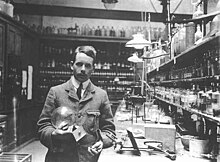


The Balliol-Trinity LaboratoriesinOxford, England, was an early chemistry laboratory at the University of Oxford.[2] The laboratory was located between Balliol College and Trinity College, hence the name.[3][4] It was especially known for physical chemistry.
Chemistry was first recognized as a separate discipline at Oxford University in the 19th century. From 1855, a chemistry laboratory existed in a basement at Balliol College.[2] In 1879, Balliol and Trinity agreed to have a laboratory at the boundary of the two colleges. The laboratory became the strongest of the Oxford college research institutions in chemistry.[5] It remained in operation until the Second World War when a new Physical Chemistry Laboratory (PCL) was constructed by Oxford University in the Science Area.[2]
The following scientists of note worked in the Balliol-Trinity Laboratories:
This physical chemistry-related article is a stub. You can help Wikipedia by expanding it. |
This article about an Oxfordshire building or structure is a stub. You can help Wikipedia by expanding it. |
This article relating to the University of Oxford is a stub. You can help Wikipedia by expanding it. |